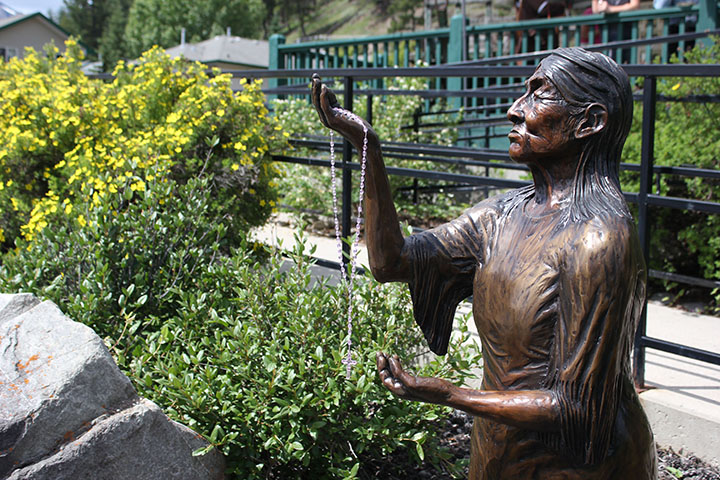The Jasper-Yellowhead Museum and Archives is located in Treaty 6 and 8 as well as the traditional lands of the Anishinabe, Aseniwuche Winewak, Dene-zaa, Nêhiyawak, Secwépemc, Stoney Nakoda, Mountain Métis and Métis. We acknowledge the past, present, and future generations of these nations who continue to steward the land.
Before 1907, the boundaries of what is now Jasper National Park did not exist. Since time immemorial, a diversity of Indigenous peoples lived on this land, and utilized and cared for the natural resources. Some groups spent almost all year in the Rocky Mountains, while others came to or through the area on a seasonal basis to access resources and ceremonial sites, to meet with other groups, or to use the mountain passes that permitted travel across the mountains. Indigenous peoples protected the land and resources according to the learned principles of conservation and their worldviews that see humans as part of, and something that must remain in balance with, the land and ecosystems on which they relied. This intimate knowledge of the land is expressed through the concept of respect – respect for the land, respect for living things, respect for Elders and respect for traditional ways.

This four-foot bronze sculpture, affectionately called “Kokum,” which means grandmother in Cree, was official unveiled in front of the Jasper Yellowhead Museum and Archives June 23. Following the ceremony a rosary was hung from her open palm. P. Clarke photo.
When Europeans came to the area in the early 1800s, Indigenous peoples continued to care for the land and resources in the Jasper area while also beginning to work as trappers, traders, interpreters and guides. The knowledge and experience of Indigenous peoples allowed European explorers and fur traders to move through the Northern Rockies into the west through the Athabasca and Yellowhead passes (now national historic sites). Some Indigenous women married European fur traders and provided local knowledge and connections to surrounding Indigenous communities. In the late 1800s, several Indigenous and Métis families homesteaded and farmed near what is now the town of Jasper, while also working as outfitters and hunters for the fur trading companies.
“In the beginning, parks were established without much consultation with the public, Aboriginal and non-Aboriginal. However, we have learned from the past. Today, we cannot imagine creating a new park, site or marine conservation area without the support and collaboration of the public, especially Aboriginal peoples…”
When Jasper Park Forest Reserve was created in 1907, later officially designated as Jasper National Park with the passing of the National Park Act in 1930, the natural landscape was initially understood as a backdrop for European settler recreation. Indigenous peoples were seen as obstacles to the enjoyment of nature. According to wilderness conservation policies at the time, Indigenous peoples were considered incompatible with nature and so couldn’t live in, hunt, or harvest within park boundaries.
After 1907, First Nations and Métis peoples (see list of Indigenous Partners) were forcibly removed and excluded from this part of their traditional territories. First Nation and Métis peoples were physically removed from the landscape, blocked from accessing it and banned from harvesting plants and animals, holding gatherings and accessing cultural sites. Furthermore, mountains, rivers and other parts of the landscape were renamed to reflect colonial names, and most visible evidence of the existence of Indigenous peoples present in the area since time immemorial, were burnt or otherwise destroyed – including Indigenous camps, cabins and homesteads.
Three years after the park was created, Indigenous people, including Métis, who lived within the park boundaries were forced to leave their homes. Some of the homesteads of Métis families who were relocated are still standing and can be visited as interpretive locations on the Snaring Road and Overlander Trail.
The creation of the first national parks disconnected Indigenous peoples from the land. This was not just a geographical disconnection but a total disconnection from an important part of their identity. Land is fundamental to practicing culture, spirituality, ways of life, and sense of self.
For many Indigenous peoples their relationship with the land is integral because everything comes from the land: food, clothes, shelter, water, and medicines, as well as stories, history, ceremonies, and law.
Summer Hours (May 19 – Mid October):
Open Daily : 10 am – 5 pm
Winter Hours (Mid October – Mid May):
Open Thursday – Sunday : 10 am – 5 pm
We respectfully acknowledge that Jasper National Park is located in Treaty 6 and 8 as well as the traditional lands of the Anishinabe, Aseniwuche Winewak, Dene-zaa, Nêhiyawak, Secwépemc, Stoney Nakoda, Mountain Métis and Métis. We acknowledge the past, present, and future generations of these nations who continue to steward the land.
We here at The Jasper-Yellowhead Historical Society gratefully acknowledge the financial support of the Alberta Museums Association in funding the Collection Deaccession and Storage Reorganization project.